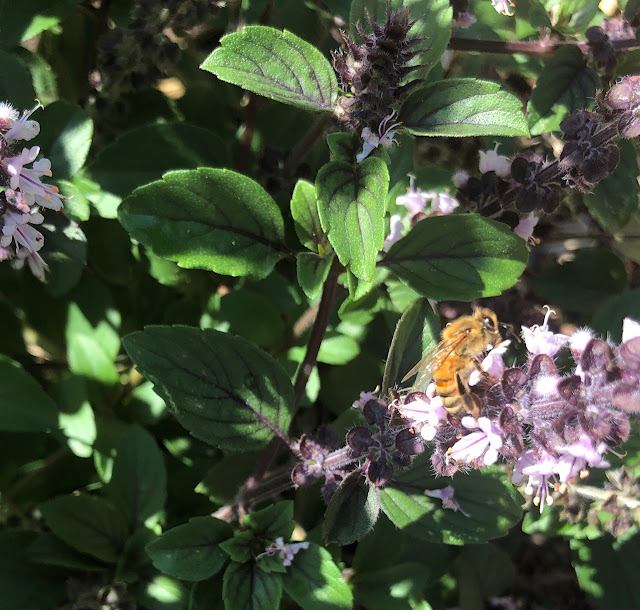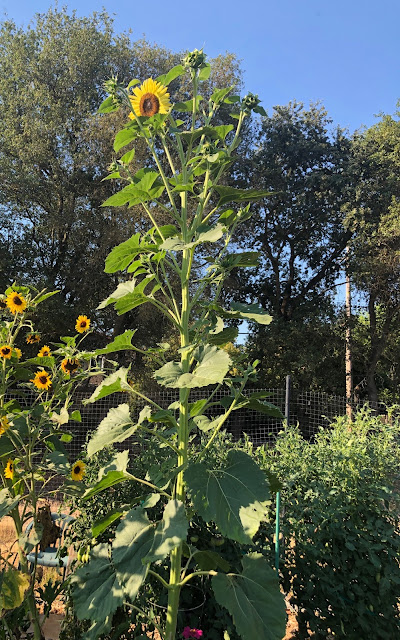
|
|
A bee gets busy on flowers of an African blue basil plant. I successfully propagated the plant from one I had last year, and I can't tell you how happy that makes me. (Photos: Kathy Morrison)
|
Some issues can be fixed; others filed away as experience
How are you feeling about your garden so far this year? A friend at my community garden this morning noted, "We're just about halfway through now, aren't we?"
It got me to thinking about how fast the spring and summer have gone, at least in terms of vegetable growing. I picked a full basket of tomatoes this morning, plus some zucchini. Just four months ago I was nursing the seedlings for those very tomatoes. Four months from Sunday it'll be Thanksgiving -- eek! -- and those plants will be history.
So the middle of harvest time offers a good opportunity to assess this year's experiences, and see what can be fixed now. Other things can be filed away as lessons. Write down your own observations, and you'll have something to refer to during the winter, when this process starts all over.
A social media thread I was looking at the other day asked for either one gardening lesson from this year or one piece of advice. So I'll start my midyear assessment with the piece of advice I offered:
1)
Extra time spent prepping the soil always pays off in the end.
I fussed over getting my vegetables planted this spring, but I knew that the west end of my plot needed help: Nothing grew very well there the past two years. I finally did a soil test, and that area showed a definite nitrogen deficiency. OK, that's fixable. A lot of blood meal went in, and the tomatoes subsequently planted in that spot are doing fine, even though they went in relatively late. This same spot will get another round of nutrient attention this winter.
2) There always are surprises.
I had just one Wine Jug tomato seedling survive the starting season. I was looking forward to seeing and tasting this Wild Boar Farms creation. But the fruit that plant has produced is small and red, not purple and jug-shaped. Seed mixup somewhere along the way, for sure. OK, try again next year.
3) Put in more stakes for tomatoes than you think you'll need.
I have 6-foot fence posts to install next to my tomato cages. I never put enough of them in the ground early, and trying to put them in later is ridiculous. Remember this next year!

|
|
This Lemon Queen sunflower is easily 9 feet tall,
the last to bloom in the garden.
|
4) Sunflowers are great shade, and even better if the plantings are staggered.
The bees love the blooms, and the plants shade my tomatoes perfectly. I haven't had to use nearly as much shade cloth this year.
5) Fight insect pests early and often. Entice more beneficials and pollinators.
Thrips were a problem with my seedlings early on, but s
pider mites are my real nemesis in summer. I'm waging a determined battle with them this year, armed with my garden hose and trigger sprayer -- and mostly winning. Wet down everything frequently, even the pathways, since mites prefer hot and dusty conditions. I've also put in a lot more plants that attract beneficial insects: chamomile, fennel, various basils (that I let flower) and cosmos. And the African blue basil that I propagated over the winter not only took, it is thriving! The bees love it. Definitely doing that again next year.
6) Peppers do quite well in pots.
I have too many pepper plants -- bells and jalapeños and shishitos -- and every one of them is growing in a container, in part shade, in my backyard. They get enough water and fertilizer and they're all really happy. That makes me happy.
7) Blueberries win over strawberries.
The strawberries have been coddled, and watered, and mulched, and fertilized, and watered, over and over. They're still not happy. The blueberries, however, responded beautifully to enough water and just enough sun.
8) Time spent in the garden, even just listening to the bees, is never wasted.
Because we can't go anywhere this summer, the garden has been my only escape, and thank goodness for it. Yes, my garden "yells" at me -- fix that, fertilize this, deadhead those -- but I can shut that off for a bit and just enjoy the peace. I wish that experience for all gardeners.


